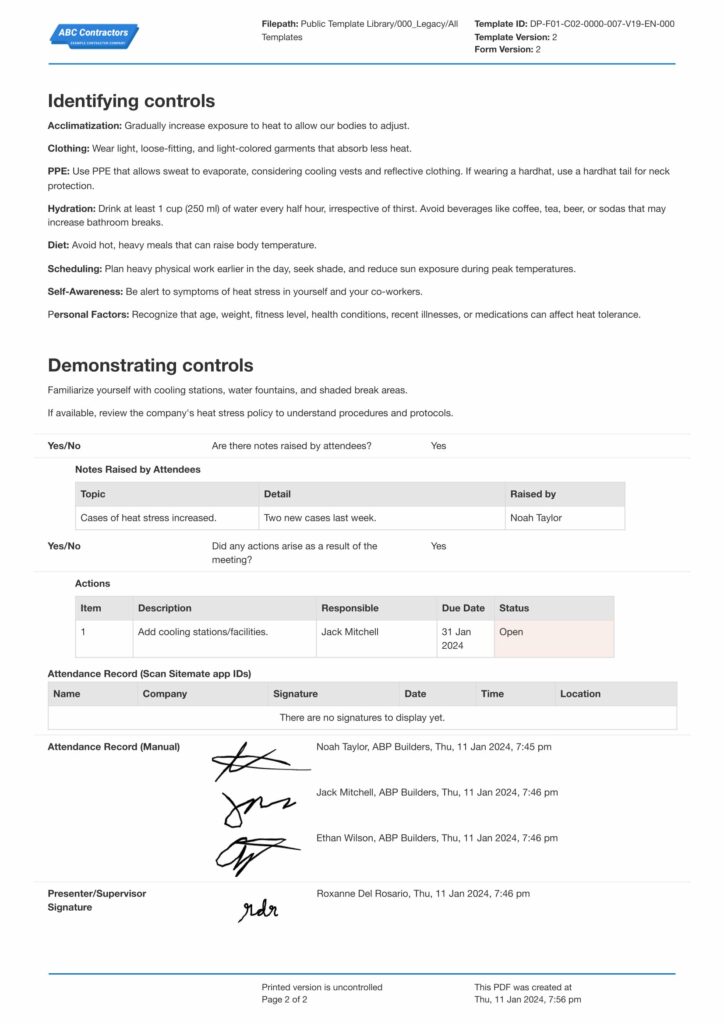Dashpivot Article – Heat Stress Prevention

Heat Stress Prevention
With rising global temperatures and frequent heatwaves, heat stress has emerged as a significant health and safety concern, particularly in occupational settings and regions experiencing extreme heat.
Preventing heat stress is crucial to maintain health, productivity, and well-being.
This article outlines effective strategies for heat stress prevention in various environments.
Understanding Heat Stress
Heat stress occurs when the body's ability to cool itself down is insufficient, leading to a buildup of body heat.
It can result from high temperatures, humidity, direct sun exposure, lack of air movement, physical exertion, and inadequate hydration or rest.
Key Strategies for Heat Stress Prevention
Hydration
The cornerstone of heat stress prevention is staying hydrated. Drink water regularly, even if you're not thirsty, and avoid dehydrating beverages like alcohol and caffeine.
Appropriate Clothing
Wear lightweight, loose-fitting, and light-coloured clothes. In occupational settings, breathable fabrics that allow sweat to evaporate are essential.
Sun Protection
Use hats, sunglasses, and sunscreen to protect against sunburn, which affects the body’s ability to cool itself.
Acclimatisation
Gradually increase exposure to hot conditions over a period of several days to weeks. This is especially important for new workers or those returning after a significant time away.
Shade and Cooling Areas
Use umbrellas, canopies, or other forms of shade in outdoor settings. In indoor environments, utilise fans or air conditioning to help cool down.
Work/Rest Cycles
Implement work/rest cycles, especially during peak heat times. Increase the frequency and length of breaks as the temperature rises.
Monitoring Weather Conditions
Keep track of temperature and humidity levels to adjust workloads and schedules accordingly.
Employee Training
Educate workers about heat stress, its symptoms, and prevention techniques. Knowledge of first aid for heat-related illnesses is also crucial. This can be reinforced with toolbox talks on heat stress, particularly before especially hot days.
Dietary Considerations
Eat smaller meals more frequently. Heavy meals can increase metabolic heat and the burden on the digestive system.
Health Monitoring
Encourage self-monitoring and buddy systems in the workplace for signs of heat stress.
Implementing Heat Stress Prevention Programs in Workplaces
Risk Assessment
Identify High-Risk Areas
Conduct a thorough analysis of the workplace to identify areas where employees are most susceptible to heat stress. This includes outdoor work sites, industrial areas with high-temperature machinery, and poorly ventilated spaces.
Evaluate Work Tasks
Assess the heat load from work tasks. Jobs involving heavy physical labor or proximity to heat sources are high-risk activities.
Employee Vulnerability: Consider the vulnerability of employees, including those who are new, unacclimatised, elderly, or have pre-existing medical conditions.
Engineering Controls
Ventilation Systems
Install and maintain efficient ventilation systems to reduce air temperature and humidity. This could include exhaust systems, air conditioning, or natural ventilation methods.
Heat Shields and Insulation
In areas with high radiant heat, use heat shields or reflective insulation to protect workers.
Cooling Technologies
Implement cooling technologies such as misting fans or chilled air systems in extremely hot work environments.
Administrative Controls
Adjust Work Schedules
Modify work schedules to avoid the hottest part of the day. Implementing shifts in the early morning or late evening can significantly reduce heat exposure.
Work-Rest Cycles
Establish work-rest cycles, particularly during peak heat conditions. The length and frequency of breaks should be adjusted based on the temperature and the physical demands of the job.
Job Rotation
Rotate employees through tasks that expose them to less heat to prevent prolonged exposure to high temperatures.
Emergency Procedures
Develop and communicate clear procedures for responding to heat-related illnesses.
Personal Protective Equipment (PPE) and Clothing
Cooling Vests
Provide cooling vests or other personal cooling devices for use in high-temperature environments.
Moisture-Wicking Clothing
Supply moisture-wicking clothing to facilitate better sweat evaporation and cooling.
Protective Gear
Ensure that protective gear like hard hats and gloves are heat-resistant and do not exacerbate heat stress.
Training and Awareness
Educational Programs
Conduct regular training sessions and toolbox talks for employees on recognising the signs of heat stress, proper hydration methods, and the importance of taking breaks.
Heat Stress Monitors
Train selected staff to use heat stress monitoring equipment to assess environmental conditions and make informed decisions about work-rest cycles.
First Aid Training
Provide first aid training to employees, focusing on the management of heat-related illnesses.
Monitoring and Evaluation
Regular Monitoring
Implement a system for regular monitoring of the work environment for temperature and humidity.
Health Surveillance
Establish a health surveillance program to monitor the effects of heat on workers, especially those in high-risk groups.
Feedback Mechanism
Create a feedback mechanism for employees to report heat stress symptoms and suggest improvements to the program.
Implementing a comprehensive heat stress prevention program in the workplace is a dynamic process that requires ongoing evaluation and adaptation.
By systematically assessing risks, utilising engineering and administrative controls, providing appropriate PPE, conducting training, and establishing monitoring protocols, employers can create a safer and more productive work environment that effectively manages the challenges of heat stress.
See how you could use a heat stress toolbox talk to help keep your team aware of what they need to do to be aware of heat stress signs and how to prevent heat stress.

Help your team to prevent heat stress by using this toolbox talk heat stress template
Prevent heat stress incidents by integrating regular toolbox talks into your safety processes
Your heat stress training and education is only useful if it's top of mind for your team when they're working on hot days - they already have a lot of distractions with work orders, documentation, inspections and more.
Use a toolbox talk heat stress template to spin up toolbox talks on heat stress prevention techniques, heat stress PPE, how to identify heat stress symptoms in yourself or others and more.
All of the fields you need to document your prepared talking points are built into the toolbox talk, with sections to capture your team's experiences and feedback to make heat stress prevention collaborative.

Toolbox Talks Slips Trips and Falls template
Manage your teams safety with regards to slips, trips and falls with this Toolbox Talk template.

Site Security Toolbox Talk template
Keep your team up to date with site security with this Toolbox Talk Site Security.

Toolbox Talk Noise Pollution template
Keep your team aware of noise pollution, ways to manage risks and reduce noise with this Toolbox Talk template.

